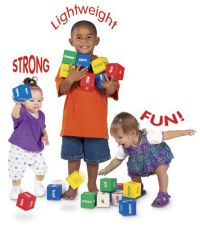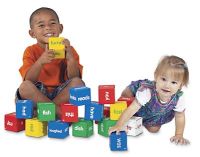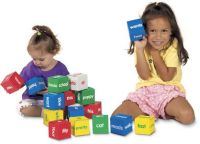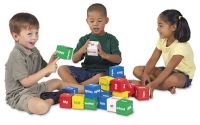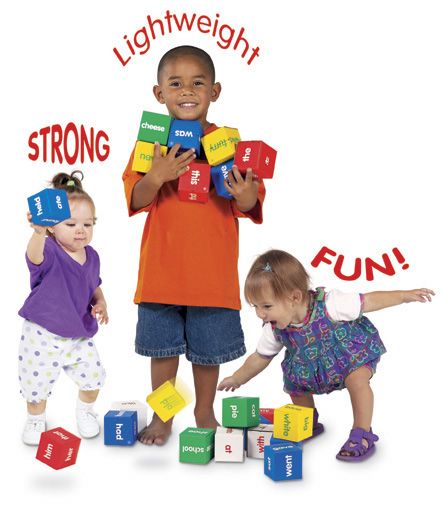Formulating sentences that are meaningful to your
child will help them learn and enjoy the process. Little Reader Blocks
allow children to easily string together words to form sentences that
have
meaning to them. This approach is far more engaging than going through
the laborious task of writing, or reading what someone else has written
and is an important step in bridging the gap between literacy and
comprehension.
The blocks are numbered from #1 through #18 on the seam side. The
numbers are circled. Blocks are color coded to denote the type of word.
The red blocks are pronouns
The blue blocks are verbs
The green blocks are nouns
The yellow blocks with green letters re adjectives
The white blocks with red letters are prepositions
To help children form sentences, start them off with just a few blocks
at a time. Because young children like to talk about themselves, it's
easiest to engage them with the 'I' pronoun block, #13, which works
with three verb blocks, #17, #4, and #5. The other pronoun blocks work
with all the verb blocks except for verb block #17. Provide a pronoun
(such as 'I'), then a verb (such as 'like') then a noun (such as
'school'). Let the child turn each block over to discover how other
words change the meaning of the sentence. If necessary, verbally fill
in any missing words, or
add a preposition block (white blocks with red letters to the piles and
let the child find the missing word themselves. As the child learns
more
words add more blocks. Following are activities to aid in their
discovery.
Toss-A-Block
Take three blocks, a pronoun, a verb, and a noun. After teaching the
child at least some of the words on the blocks, toss them out and see
what sentence it makes. Have the child read it. Help him/her with words
they haven't yet learned. Add verbally any missing prepositions
or add a preposition block (the white block with red letters) and let
the child pick which preposition goes where. As the child recognizes
more
and more words, increase the number of blocks in the "toss".
Related activity: Switch the word order and explore how these change
the meaning, for example "the mouse is in the shoe" vs. "the shoe
is in the mouse!"
Pick-A-Block
Toss all the blocks on on the floor and have the child pick
out words to make their own sentence. You can help them by providing
the first few words, such as, 'my 'brother' 'likes' ....
Draw-A-Sentence
After the child has made a sentence, have them draw a picture of
it. Whimsical sentences make great pictures!
